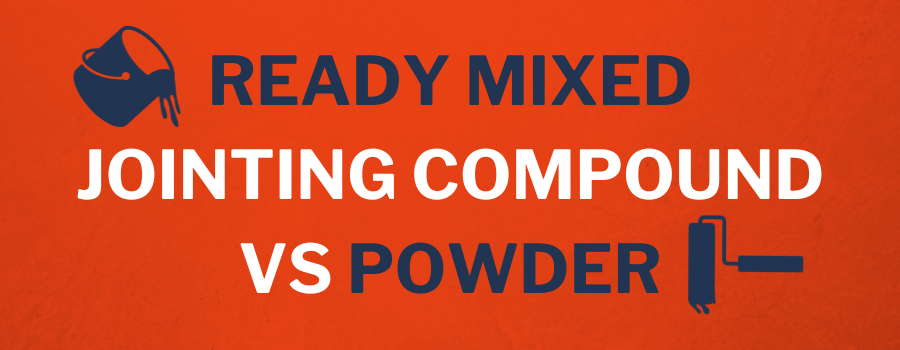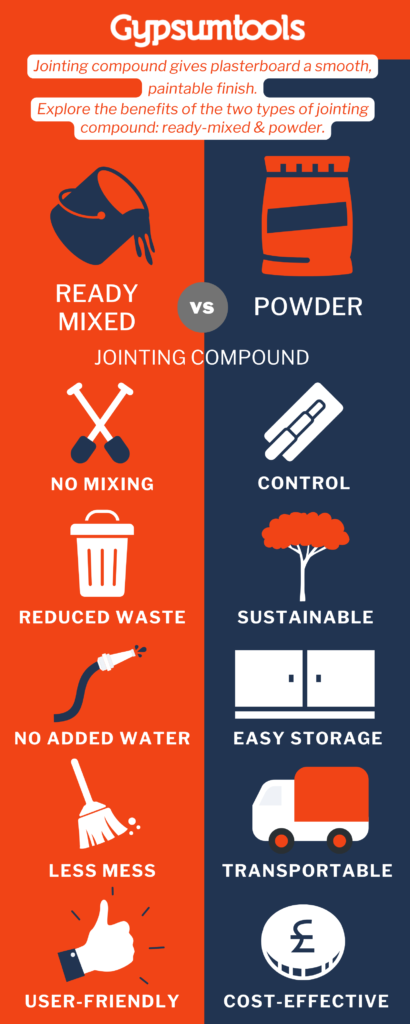
1. Introduction
2. Ready Mixed Jointing Compound
4. Should I use Ready Mixed or Powder Jointing Compound?
5. Advice for Using Ready Mixed Jointing Compound
6. Tips for Using Powder Jointing Compound
7. Summary
1. Introduction

In the world of drywalling, achieving a smooth, seamless, and visually appealing finish is the ultimate goal.
To cover gaps and create a flawless surface, professionals and DIY enthusiasts alike rely on a versatile material known as jointing compound.
In this guide, we will explore the two main types of jointing compound: ready-mixed and powder.
But first, let’s explore what jointing compound is and how it’s used.
1.1. What is a Jointing Compound?
Jointing compound is a material used in the finishing of drywall or plasterboard.
Drywall consists of large panels of gypsum board or plasterboard. Jointing compound is a paste-like substance used on drywall, specifically formulated for filling gaps and finishing corner beads, trims and fasteners.
The end result of applying jointing compound is to repair or improve the appearance of drywall, leaving a smooth, structurally sound surface ready for painting.
1.2. How is Jointing Compound Used?
The application of jointing compound begins with the installation of drywall panels, leaving gaps and joints between them. Once the drywall is installed, the process of application can begin.
First, a fibreglass or paper tape is applied over the joints to reinforce them and prevent any future cracking.
A layer of jointing compound is spread over the taped joints, embedding the tape and filling any depressions or gaps. This coat is typically wider than the tape itself.
Subsequent coats are then applied, each wider than the previous one, to feather the edges and create a smooth, seamless transition between the wall or ceiling and the joints. Each coat is allowed to dry and is sanded before applying the next.
After the compound has dried, it is sanded to achieve a smooth surface. The final coat may involve a thinner application, known as skim coating, to further finesse the finish.
2. Ready Mixed Jointing Compound

As the name suggests, ready mixed jointing compound is a pre-mixed product.
This product conveniently comes ready to use directly from the container, meaning you can start the application straight away.
2.1. Benefits of Ready Mixed Jointing Compound
No Mixing
The core benefit of ready-mixed jointing compound is that it doesn’t require mixing. This means you can get to work straight away – cutting out the time and effort needed to create a usable mixture and maximising convenience.
Uniform Consistency
Without the need for mixing, you also don’t need to worry about creating the right consistency. This not only reduces waste from mixing errors, but also means the mixture quality remains consistent across the project.
Drying Time
Another benefit of uniform consistency is that the drying time is the same across the whole project. By knowing how long the coat will take to dry, you are able to plan ahead and work systematically during the application process.
Waste Reduction
There is a reduction in waste when it comes to knowing the amount of usable product you have. By purchasing the material premixed, you can get the right amount for the job, instead of iteratively adding powder and water based on the consistency of the mixture.
No Additional Water
Additionally, premixed jointing compound doesn’t require any additional water to be added. So, if you’re working in an environment where water is not readily available or inconvenient to transport, ready-mixed is a practical solution.
Reduced Mess
Applying jointing compound straight from the container reduces the mess involved in finishing drywall. With ready mixed, the chance of spillages and the time needed to clean is drastically reduced.
User-Friendly
With DIYers in mind, ready mixed jointing compound is incredibly easy to use. When used in combination with drywall tape, the application process is quick and convenient and provides a high quality finish, even for those with minimal experience.
3. Powder Jointing Compound

Powder jointing compound is non-mixed. It is purchased as a white powder, and when mixed with adequate water, forms a paste that can be applied to plasterboard. Mixing the compound can be done either manually, or by attaching a mixing paddle to a drill.
3.1. Benefits of Powder Jointing Compound
Control Consistency
By adjusting the amount of water added, you can control the consistency of the powder mixture. This customization allows you to tailor the compound to diverse project needs, from filling small cracks to creating a smooth finish on joints.
Easy Dry Storage
Since powder jointing compound is stored in a dry, powdered form, it takes up less space and generally has a longer shelf life compared to ready mixed. This means large quantities of dry powder can be neatly stored for extended periods without degrading.
Cost-Effective
Powder jointing compound tends to be cheaper than its ready mixed counterparts. This cost-effectiveness is especially attractive for both budget-conscious individuals and on large-scale projects where cost outweighs convenience.
Transportable
The lightweight nature of powder simplifies transportation, handling, and mixing. This is especially important for professionals who need to carry materials around job sites or DIY enthusiasts who find lighter materials more manageable.
Sustainability
Due to its reduced packaging and light weight, powder jointing compound could be considered to be more environmentally friendly. This is a topical benefit in the construction industry today where sustainability is often a high priority.
4. Should I Use Ready Mixed or Powder?
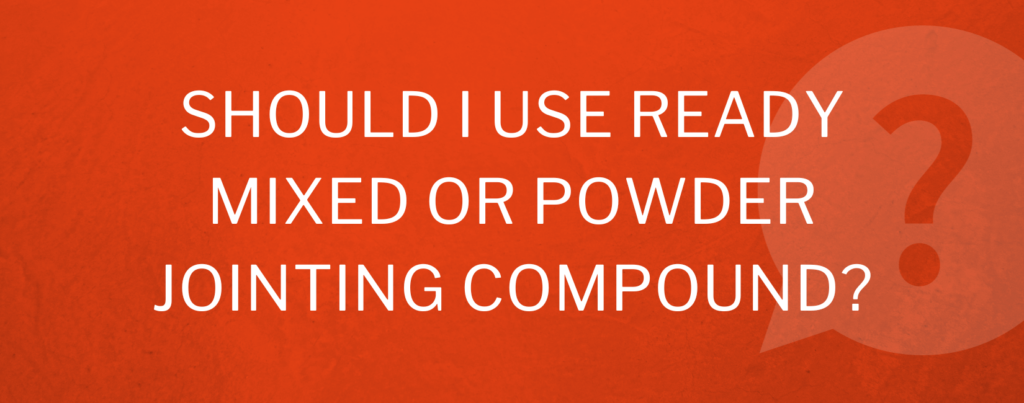
When it comes to choosing between ready mixed and powder jointing compounds for your project, several important factors come into play.
You should consider your level of experience, budget, the size and complexity of your project and time constraints when deciding whether to use ready mixed or powder.
Level of Experience
Ready mixed compounds are more user friendly and don’t require you to make a usable mixture yourself, making them suitable for individuals with any level of experience.
However, if you’re a professional tradesmen or a skilled DIYer, you may be more appreciative of the ability to customise the consistency of your mixture, making powder jointing compound a better fit.
Budget
While convenient, ready mixed compounds are often more expensive than powder. So where cost is a critical factor, powder jointing compound may be a more suitable option.
Size/Number of Projects
For small-scale projects or quick touch-ups, ready mixed compounds offer convenience and can save time. You may also know exactly how much product you need to complete the job, so to minimise waste, premixed may be more appropriate.
Whereas, the light weight and cost efficiency of powder compounds may provide a stronger appeal when working on large or multiple projects, as it could drastically reduce your material spend and make transporting your supplies easier.
Complexity of Project
Ready mixed compounds are ideal for straightforward, standard drywall projects where simplicity is a priority.
Powder compounds are more suitable for complex projects due to their versatility, allowing you to vary consistencies and extend drying times based on the project needs.
Time Constraints
If you’re working on a tight schedule, ready mixed compounds are a better choice for speed. By cutting out the task of mixing, you can start the application process straight away, making for a faster project time.
5. Advice for Using Ready Mixed Jointing Compound
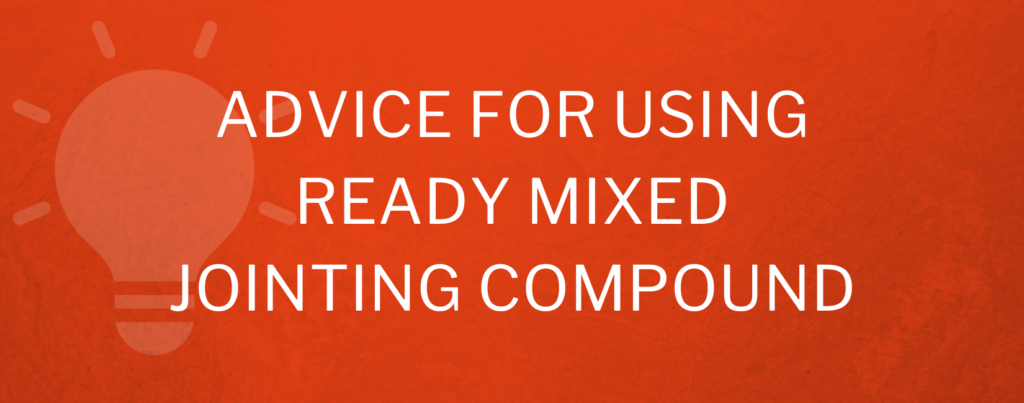
When working with ready mixed jointing compound there are some key tips to help you achieve high quality results.
Stir Before Use
Before use, stir the compound thoroughly to ensure you get a consistent texture. However, avoid over-stirring, as this can shorten the hardening time and add air bubbles into the mixture.
Stirring only the amount you plan to use within a reasonable timeframe also helps to prevent the mixture from drying out.
Don’t Overwork the Mixture
When applying the compound, resist the temptation to excessively rework it after application. Overworking can lead to a less smooth finish and may cause the compound to lose adhesion and begin cracking or peeling.
Open Time
You need to be aware of the open time of the compound you’re using. Open time refers to the amount of time the premix remains workable before it starts to set.
As the mixture has been pre-made, you can follow the manufacturer’s instructions to ensure you apply the compound within the specified timeframe.
Storage
Finally, if you have spare ready mixed jointing compound, it’s important to know how to store it for use on your next project.
For optimal storage, ensure there is no dried compound that could fall into the mixture, pour half an inch of clean water onto the top of the compound, press the lid on tightly and remember to remove the water before next use.
When stored properly, ready mixed can be usable for up to 9 months.
6. Tips for Using Powder Jointing Compound
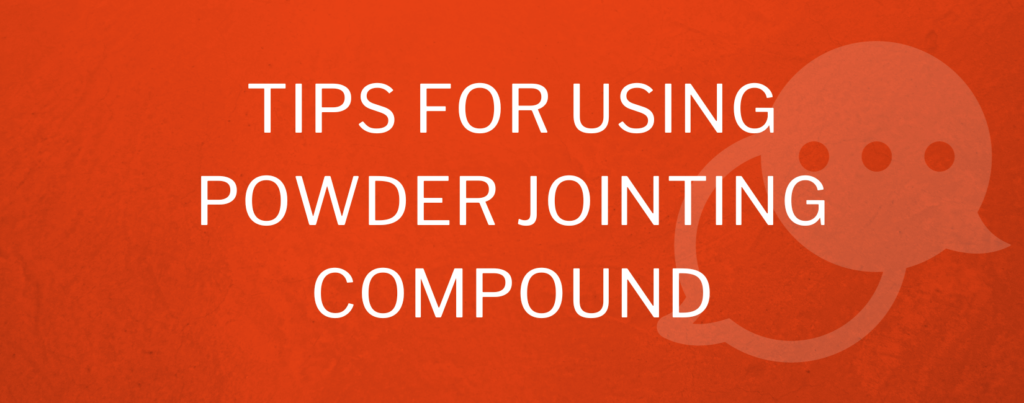
To get the best results on your finishing projects, there are some key things to keep in mind when mixing and storing the product.
Mixing
The key to a high-quality finish is a suitable jointing compound consistency. This consistency comes from properly mixing the powder and water.
Start by carefully measuring the required amount of powder and add it to a clean mixing container. Use a mixing paddle or a stir stick to combine the powder with the appropriate amount of water.
Follow the manufacturer’s recommended water-to-powder ratio for the optimum consistency. However it is important to note, adding the water is an iterative process, so add the water incrementally, keeping an eye on the consistency of the mixture.
Ensure you mix thoroughly to achieve a smooth, lump-free paste.
Slaking
After mixing, allow the compound to slake for a few minutes. Slaking allows the powder to absorb the water fully and reach its ideal working consistency.
During this time, you may notice the mixture thickening slightly. Stir it again to maintain the desired consistency before use.
Adjust the Consistency
Check the compound’s consistency after mixing and slaking. If it’s too thick or too thin for your intended application, you can make adjustments.
To thin the jointing compound, add a small amount of water and mix thoroughly. To thicken it, incorporate more powder. Make gradual adjustments and mix well until you achieve the desired result.
Storage
If you have any leftover powder jointing compound, store it correctly to prevent moisture absorption and clumping.
You store mixed powder jointing compound in a similar way to pre-mixed – clean the edges of the container, pour water over the leftover compound and seal the container.
However, when using powder, you may not have a lid for your container, as is often the case with ready-mixed products. In this case, create an airtight seal using something you have to hand, such as plastic wrap.
Dissimilarly to ready-mixed, the storage time, particularly without an airtight lid, is drastically reduced. If you’re not using the remaining product in the next day or two, the leftover compound will become unusable.
The issues associated with storing mixed powder jointing compound highlights the importance of only mixing the estimated amount needed.
7. Summary

This article has explored the respective benefits of ready mixed and powder jointing compounds.
Ready mixed is a premade product, taking out the hassle of mixing. It is quick and easy to use and can save time on cleaning up.
However, it’s important to consider that ready mixed is less cost-effective than its powder counterpart, with open time, overworking and storage needing to be considered when using this product.
These features make ready mixed jointing compound ideal for smaller, simpler projects where time is a critical factor, or for those with limited drywall finishing experience.
Powder jointing compound is ideal for those who want a customizable consistency and to buy in bulk. This is because before mixing, powder jointing compound is cost-effective, lighter in weight, easy to store and boasts a longer shelf life compared to ready mixed.
It’s important to consider the mixing process when choosing the right product. Powder jointing compound requires you to create a usable consistency, and once mixed, the leftovers have a short storage time.
If you’re a plasterer by trade or an apt DIYer working on a large or complex job, powder jointing compound is the ideal solution. Similarly, if you are working on a budget or environmentally conscious project, powder comes out on top.
As discussed, both ready mixed and powder jointing compound have their advantages and considerations. It’s important to weigh these up alongside your personal preferences when deciding which product is best suited to your project.
Once you’ve decided which form of jointing compound is right for you, browse our range of jointing compounds at Gypsum to find the perfect product at a great price.

